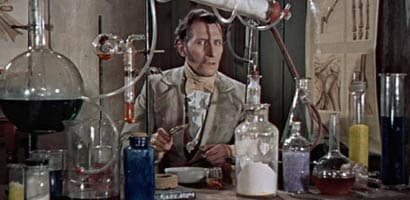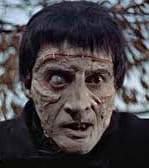Frankenstein
Critique • Text • Frankenstein at the movies
 Frontispiece, first illustrated edition 1831
Frontispiece, first illustrated edition 1831Original title
Frankenstein; or, The Modern Prometheus
First publication
1818
Literary form
Novel
Genre
Literary, science fiction, horror
Writing language
English
Author's country
England
Length
Approx. 78,000 words

Peter Cushing cooks up the monster in the British-made Curse of Frankenstein.
It's alive—again
The Curse of Frankenstein (1957): Film, 83 minutes; director Terence Fisher; writers Jimmy Sangster; featuring Peter Cushing, Christopher Lee
After the American run of Frankenstein films petered out near the mid-twentieth century, the monster was becoming a kid's comic character.
But then the British took up the tale and took it seriously. Not so much continuing the now very confused storyline, but re-imagining the Frankenstein myth from the beginning.
Which—come to think of it—is only fair, since Frankenstein was an English creation in the first place.
The doctor is in
The Hammer Film studios started with The Curse of Frankenstein, pairing Peter Cushing and Christopher Lee as the doctor and monster respectively and bringing a more psychological flavour to the tale.
Once again the film is only very loosely based on the Shelley story. Victor Frankenstein (at least he's named Victor now, rather than Henry as in the Universal flicks) carries out experiments on reanimating dead animals, becoming obsessed with creating a superior human being. He turns evil himself, stooping to murder to protect his project. He uses the flawed creature he creates to carry out further dirty work and is brought back to his senses only when his fiancée is threatened by it.
As in the novel, the attention is paid more to Frankenstein the scientist than to his creation.
The film is book-ended by Cushing's Frankenstein in prison, recounting his story of creating and trying to control the monster, although it's never clear how sane the storyteller is or how much he should be believed. In the main part of the story though, he's a steely-eyed, determined man, not given to the previous screen Frankenstein's hysterics.
Lee's monster is also closer to how a Mary Shelley reader might imagine him: the square-topped head and neck bolts are gone, and he looks like he's been stitched together from dead body parts. He's also clearly psychotic.
The film's colour is beautifully rich, which is welcome after all those black-and-white Hollywood movies.
By today's standards this is a low-keyed film for the genre. But at the time it was considered a grisly, bloody sensation. Its success, coupled with that of the studio's Dracula the next year, turned Cushing and Lee into major horror and suspense stars.
— Eric
Critique • Text • Frankenstein at the movies
1931, 1935, 1939, 1942–1948, 1957, 1958–1970, 1973–1996, 1994, 2014


